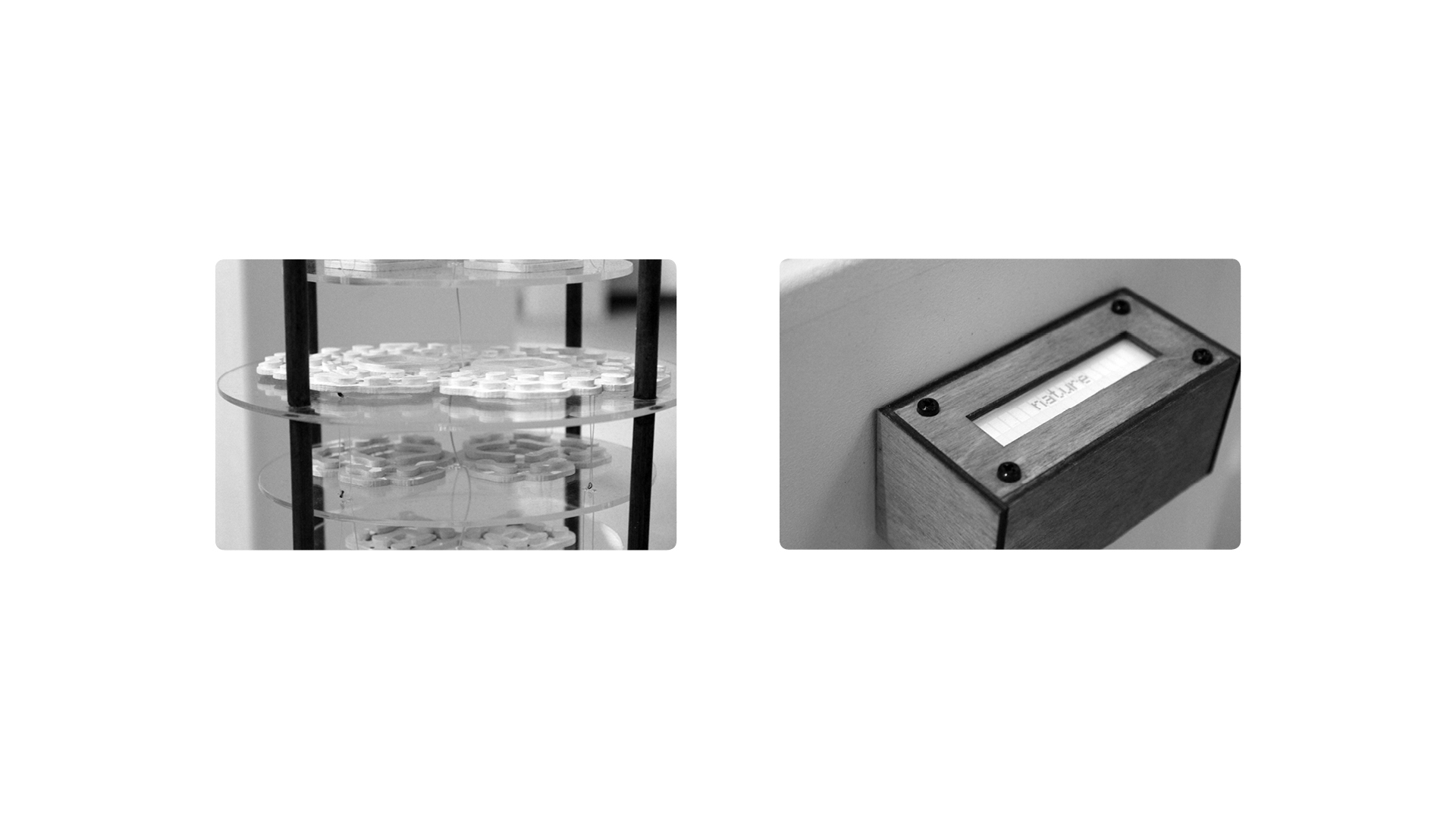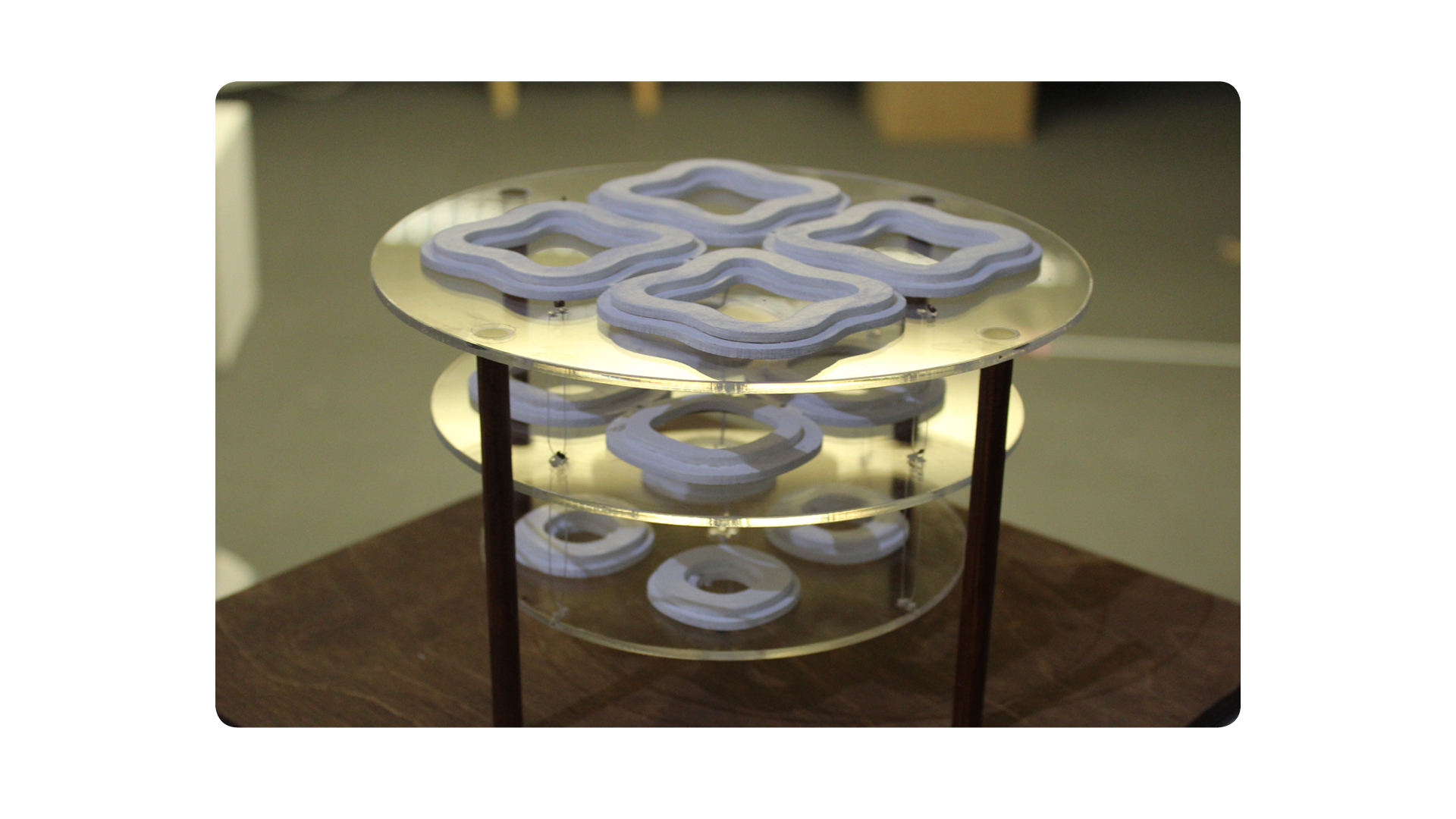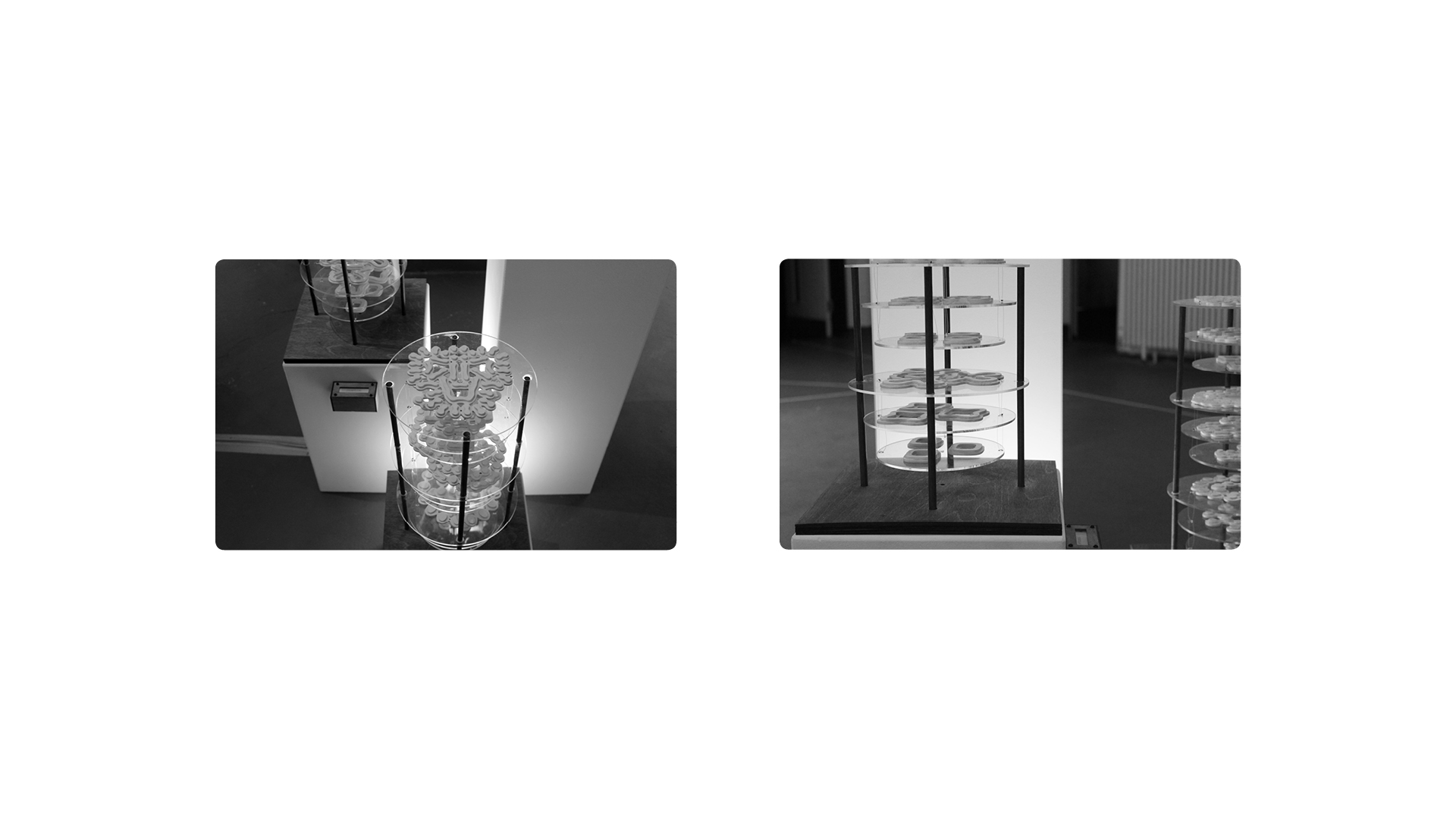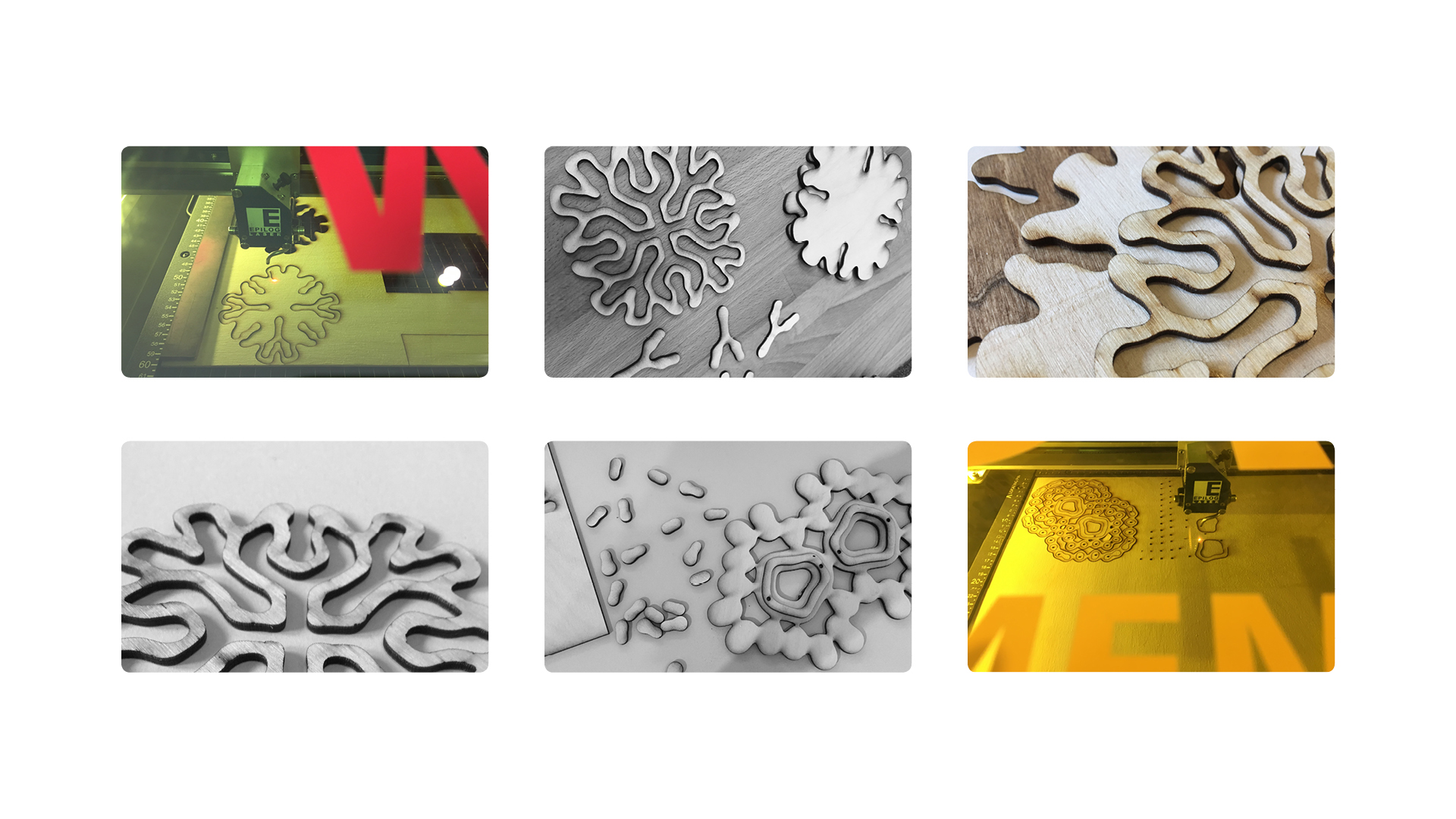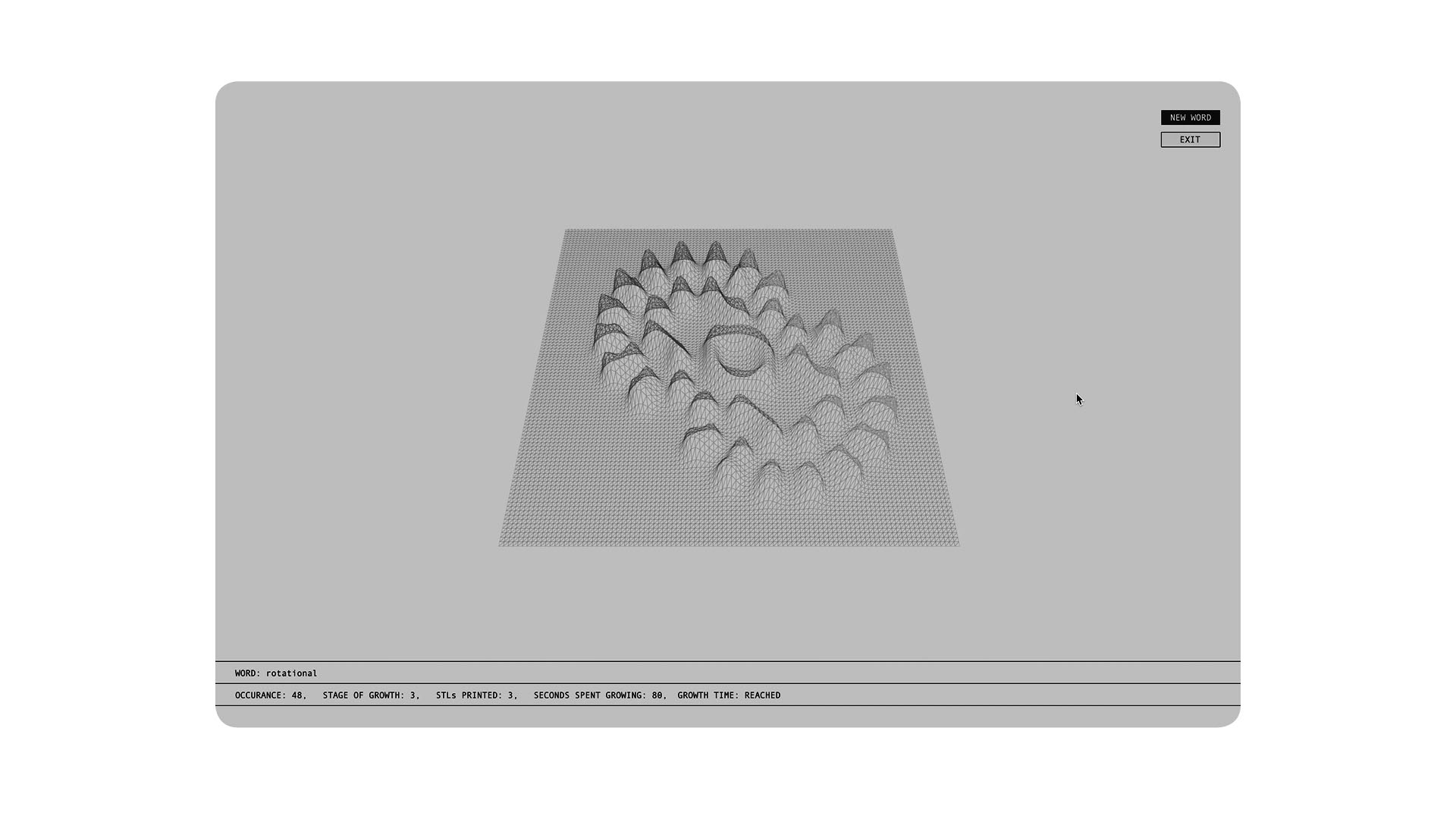The Language of Growth
This piece is exploring the entangled relations between humans, computation, nature, ownership and discovery. It came from a fascination with the idea that algorithms and formulas can be subject to patents, particularly those that claim to synthesise nature.
produced by: Isabel McLellan
Concept and background research:
I began the project wanting to explore the idea of a kinetic sculpture inspired by the mechanics of nature, and initial research focused on the innovative soft robotics being produced at institutions like MIT. [1] This came from generally being curious about the ways in which humans attempt to mimic and describe nature through maths and code, areas that feel instinctively very oppositional, which is what makes their bond so interesting.
However at this point I was struggling with the computational aspect of my concept. I wanted it to be natural in feeling, but I lacked a specific direction or motivation to make it so. Making arbitrary soft robotics with their own behaviours didn’t feel like a strong enough connection, they would still be man made robots poorly mimicking something they are not, and my experience in this area is limited. So with this in mind I began searching for a direction.
I decided to explore algorithms that attempt to simulate, mimic, or describe natural growth, patterns and forms found in nature. [4] [5] I have previously explored fractal trees and l-systems, so I wanted to expand my knowledge elsewhere. This is how I came to find the ‘Superformula,’ a generalization of the previously established superellipse, proposed by Johan Gielis. After experimenting with this formula in a few programs, I discovered what I found to be the most interesting thing about this formula in my eyes, that Gielis has attempted, and successfully, patented it. [6] I had always assumed that mathematics was an area that patents could not touch, and whilst this is true in the sense of the pure formula, almost every application of it you could think of for art and design is prohibited without permission (and presumably money). The crossover of computation and the law is something that I have previously explored as part of the Theory module, but I had focused more along the route of ethics in AI, digital citizenship and issues further along the political spectrum, rather than the ecological.
I wanted to use the patent itself rather than the formula it describes as a basis and backbone for the project, with a particular focus on its language. It is the way it is written that allows it to exist, by circumventing ownership of the formula itself and instead discussing only the possible creative applications. I wanted to subvert it, using something that aims to prohibit and restrict to instead generate growth. I explored using data from a language analysis of the patent to feed into another formula I had been researching that has also been claimed to synthesise nature, but has not been patented, and is open to use by all - reaction diffusion. [7] [9] I liked the concept of pairing something that is restricted with something that is free, and expressing one through the other.
Technical:
For the main program I used Processing, creating a reaction diffusion 3D mesh that I could later fabricate in physical material. This process was initially very challenging, from issues figuring out how to make the structure 3 dimensional, to how to create a closed mesh of the desired resolution and scale, and how to capture that growing form at specific moments in time to be saved, exported and fabricated. Figuring out these issues involved a lot of translating between coding languages in order to find one that suited the project best.
A technical concern I grappled with at this stage was the question of how to transform a 3D shape from an equation written in Processing, into a 3D shape I could hold. It didn’t need to be exactly the final form that it would take in terms of material and appearance, just a prototype object. What I gathered from initial research is that a processing library would be needed to convert the shape into a file type that could be passed to a 3D printing software, or one that could lasercut slices. [12] I eventually managed to do this and at the specific stages of growth that I had required, to ensure consistency across each set of shapes.
The language analysis was also done in processing, and it consisted of a function to search for the most commonly used complex words of the text, to find more interesting results. It was then a case of figuring out how to use this data to influence growth; choosing a word, analysing how prevalent it is in the text, using this to determine feed rate and the number of chemical patches that begin the diffusion (the more common a word is the faster the feed rate and the higher number of chemical patches).
A technical concern that I managed to overcome was a memory issue, as the program ran for substantial length of time, an error with memory leaking would cause the program to crash. As I had hopes of making it so the shapes could shrink and regrow in an endless loop, I needed the program to be able to run for a long time. I fixed this by removing and simplifying each section of the program systematically until the error disappeared, allowing me to locate the problem. It was in the passing of data between parts of the program and the generation of new variables from this, which I managed to resolve.
After this fix I could edit the code so that with the click of a button, the shape would shrink back to the centre and a new word would be chosen from the patent to inform the growth of a new shape. This made for a more interesting and satisfying program to use.
For the final structure, I also used an Arduino and a 16x2 LCD screen which had a text display of randomly chosen words from the most common words used within the program. In the choosing of random words from this list, often poetic couplings would arise.
Future development:
I see lots of paths that I would like to take to explore the themes of this project in more depth and conceptual iterations. In this version, I wanted the aesthetics of the sculptures to have almost scientific or museum connotations, as museums are places in which nature has been claimed by humans and used in a way as art, as well as knowledge enhancement and a celebration of discovery. So I made the pieces very precise and geometric, using acrylic and wood. This is because these forms are not natural, and therefore in the code they can be paused, manipulated and controlled.
However, to fit the theme in a different way in alternative or future iteration of this idea I’d like to create a feeling of these hybrid forms starting to reclaim themselves from human control and ownership, maybe beginning to become more wild and unpredictable. This could be present both in the code and the presentation, perhaps a part of the code that is controlled by data from nature, or random chance. And the forms could outgrow their enclosures, reminiscent of plants that take over human spaces, like moss and ivy.
I would also like to explore the idea of subverting patents in a more general sense, to explore the ways in which they help or hinder technological and creative growth and development. An example in this context would be at what point of altering a patented algorithm does it become a different one, and therefore acceptable to use? What aestheic effects does this have? Can it still produce something meaningful or will the output look ‘broken’. On examination day we discussed these ideas, and the ways in which patenting has potentially gone too far, like the patenting of the ‘Vantablack.’ [8]
Self evaluation:
Overall I am happy with the project in terms of learning new skills and discovering new avenues and conceptual threads that could inform my future practice. However, I do believe that I could have struck a better balance between what is accessible on the surface of the piece and what context lies within and beneath.
I would have like the meaning to be more transparent and accessible, perhaps through interactive elements, or more of the patent visible in the work. I think in future developments I would make a stronger link between concept and form, and think more about the story and narrative that can be picked up purely by interacting with the piece without reading about it. I would simplify the concept to have work with more clarity, and ultimately more emotional impact.
I would also liked to have included more physical computing elements into the piece, but after some failed experiments with capacitive sensing to trigger the LCD text information it became a static, non-interactive piece. I wasn't sure again of the balance here, should it be computational in the experience or more of a traditional, sculptural piece with the computation only in the process?
References:
Initial Research:
[1] https://www.csail.mit.edu/
[2] https://www.forbes.com/sites/jvchamary/2016/07/27/no-mans-sky-superformula/
[3] https://arstechnica.com/gaming/2016/07/no-mans-sky-faces-potential-patent-fight-over-use-of-superformula/
[4] https://www.wolframscience.com/nks/p423--biological-pigmentation-patterns/
[5] http://formandcode.com/code-examples/simulate-dla
[6] https://patents.justia.com/patent/20170018101
[7] https://www.karlsims.com/rd.html
[8]https://www.wired.com/story/vantablack-anish-kapoor-stuart-semple/
Code:
[9] Daniel Shiffman's Reaction Diffusion tutorial, Video: https://youtu.be/BV9ny785UNc Code: https://thecodingtrain.com/CodingChallenges/013-reactiondiffusion-p5.html
[10] Daniel Shiffman's Perlin Noise Terrain https://www.youtube.com/watch?v=IKB1hWWedMk
[11] https://processing.org/tutorials/data/
[12] https://github.com/mariuswatz/modelbuilder
































































